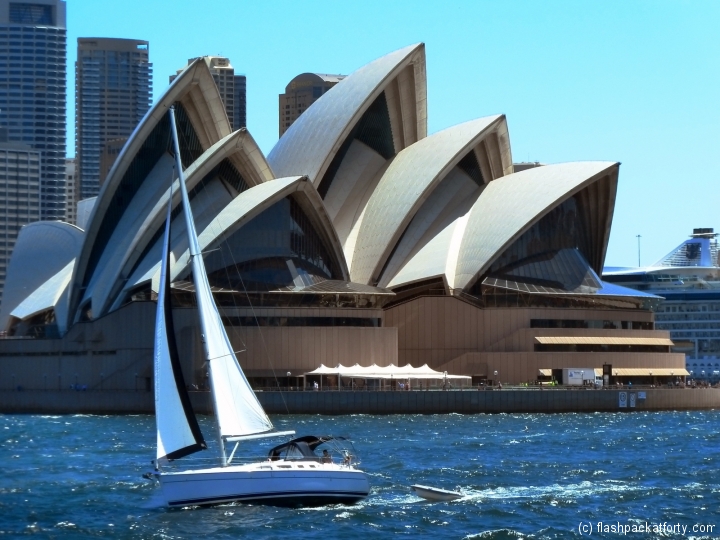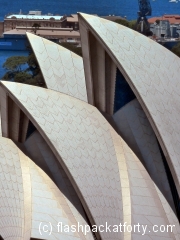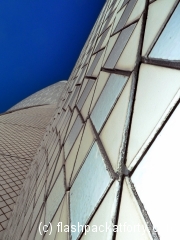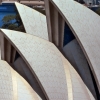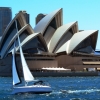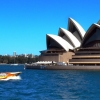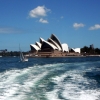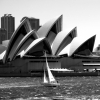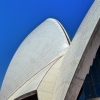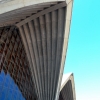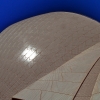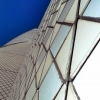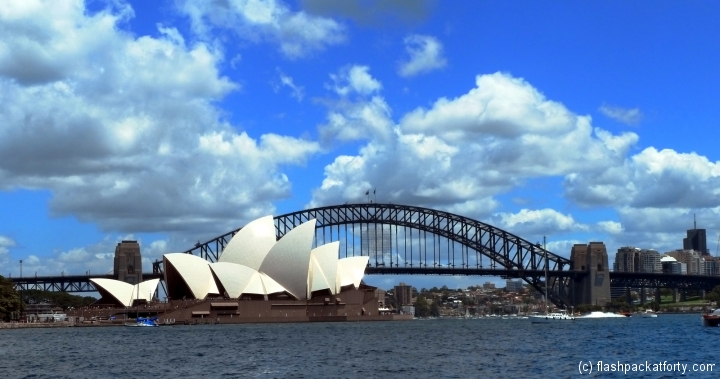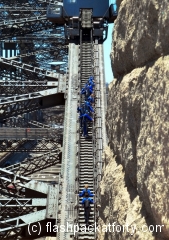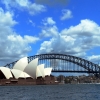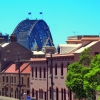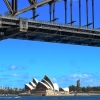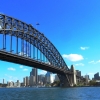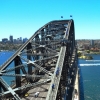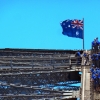Australia: Sydney Opera House and Bridge
There are some who believe that architecture isn’t important, that it is merely a straightforward academic function to design a building that serves the purpose of the activities that are going into it, across it or under it.
Those people are fools and the two icons that stand proudly facing each other across Sydney Harbour are testament to that fact. We should round the naysayers up and impale them one by one on the points of the each of the arches of the Opera House until they admit they were wrong.
The Lady of the Harbour
You may realise by now that I like architecture, I especially like clever, controversial and daring architecture and the Opera House fits all of those definitions quite beautifully.
I first spotted the little beauty from the airplane window as we made our descent into Sydney and I nearly broke Johns arm as I jabbed at him and pointed out of the window in excitement.
It wasn’t until the next morning that I got to see her in person. As we approached Circular Quay we stepped through the covered entrance and out onto the Quay and there she was glistening in the sun, looking proud for all the thousands of tourists who at very moment you knew were snapping her image into their million megapixel digital sensors.
The lenses pry from boats and ferries in the harbour, from the bridge and headlands that surround her. They get up close and personal right under her nose and peek and prod at all of her majestic curves and hard inner angles she forms into the space that surrounds her.
Then they go and put their bodily images between the sensor and the soporific splendour of her and spoil the whole thing.
Well we were no different, there are lots of shots of us in the way of the opera house, but for this post we shall simply let you revel in the beauty of her design and hopefully, like me will come to love her.
The most surprising thing to me of the Opera House that it is not white or clad in some continuous metal sheet as I had expected. She has a beautiful snake skin texture up close made up of thousand of small (definitely not white) tiles.
This was what made me fall completely and absolutely head over heels in love with her when I saw her up close. We didn’t do the tour, partly because it was over a two hour wait to get on one. On the other hand I was happy to remember her from the outside and the promise we made to ourselves to return and see her insides not on a tour, but during a performance, as she was designed to be used.
After all of that gooey outpouring here are some cold hard facts for those that prefer their posts a bit more Manly.
The Manly Stuff
- The genius behind the building is an architect by the name of Jørn Utzon.
- Prior to winning the competition to design what was to become one of the most famous landmarks in the world, he had primarily worked on domestic architecture.
- He did not attend the official opening as by that time he had been sacked from the project due to cost overruns and political interference following a change of government
- It was opened by dear Queen Lizzy herself on 20 October 1973., Jørn Utzon, wasn’t invited or even acknowledged as the designer at the ceremony.
- The first stage (laying the base on which she sits, started on 2 March 1959 but it was not completed until 1973, having cost $102 million – way over budget and time (I told you it was controversial)
- Utzon received the Pritzker Prize, one of architecture’s highest honours, in 2003. The Pritzker Prize citation stated:
- “ There is no doubt that the Sydney Opera House is his masterpiece. It is one of the great iconic buildings of the 20th century, an image of great beauty that has become known throughout the world – a symbol for not only a city, but a whole country and continent”
- It was made a UNESCO World Heritage Site on 28 June 2007
- If the 14 shells of the building were combined they would form a perfect sphere. It is said that his inspirational moment solving this puzzle came to Utzon while he was peeling an orange.
- It has been referenced in an episode of Fawlty Towers
- Well, may I ask what you were expecting to see out of a Torquay hotel bedroom window? Sydney Opera House, perhaps? The Hanging Gardens of Babylon? Herds of wildebeasts swinging majestically… Basil Fawlty
The Older Brother
If the Opera House is the graceful ballet dancer pirouetting on the Harbour, then the Bridge is the big bloke at the back of the orchestra battering the kettle drums.
There is little graceful about the megaton marvel that spans the divide between the Rock and Milsons Point. But in the same way that SUBO finally found an audience, you don’t have to be beautiful or graceful to attract attention from millions around the world.
With the Opera House you have to be on the harbour edge to even catch a glimpse of her. She is the shy lady of the harbour whereas the bridge is her older more cocky brother, more forthright. You will catch glimpses of his arches as you wander around the city inner edges popping up in between skyscrapers in the CBD or along Victorian house lined streets in the Rocks.
We have flown over it, walked across it, rode a ferry under it, seen the fireworks light it up on NYE, and been up one of its pylons. We didn’t walk up it (they wanted over £200 to play and that amount in the flashpacking budget will be spent elsewhere).
From whatever angle you peep at it, it will provide you with a stunning new perspective on its architectural and engineering excellence.
Bridge Basics
- From its inception, it was designed to carry lanes of cars, trains in two directions and hundreds of people across it, so it had to be big and it had to be strong
- The official ceremony to mark the “turning of the first sod” occurred on 28 July 1923, at Milsons Point
- It was designed and built by English firm Dorman Long and Co Ltd of Middlesbrough, and opened in 1932 (no wonder it looks rather like the Tyne Bridge)
- It is the world’s widest long-span bridge
- Until 1967 the Harbour Bridge was Sydney’s tallest structure
- Paul Hogan, who worked as a bridge painter before rising to Crocodile Dundee fame in the 1970’s
A rather different post this, I hope I have done it justice with my imagery.

